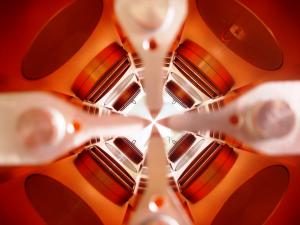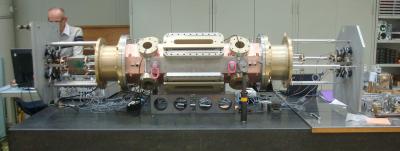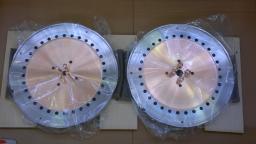The aim of the LINAC4 project is to build a linear accelerator for H– ions at 160 MeV to replace the LINAC2 accelerator as injector into the Proton Synchrotron Booster (PSB). This new linear accelerator will double the brightness of the beam out of the PSB, making it possible to increase the current in all the LHC injectors, and ultimately increasing the brightness of the LHC itself. LINAC4 will be installed in a new tunnel and connected to the transfer line to the PSB. It will consist of an H– ion source, a radio frequency quadrupole (RFQ), a chopper, and a series of accelerating cells occupying a total length of 86 meters. The RFQ was designed by SACM, built by CERN, and adjusted on site by a CEA team. It is currently being conditioned at the 3 MeV test stand prior transfer to its final location, planned for late 2013.
The LINAC4 RFQ operates at 352.2 MHz and should deliver an 80 mA beam at 3 MeV in pulsed mode. Using technology developed for IPHI, it consists of a single three-meter long segment made up of three one-meter sections. Thirty two tuning slugs will be used to obtain the required inter-electrode voltage of 78.27 kV with an accuracy of the order of one per cent. The radio frequency (RF) power is coupled via an iris, fed by impedance ridged waveguide impedance transformer. The injected power will be around 600 kW for a beam power of 210 kW.
This RFQ was designed by SACM and constructed entirely by CERN. Radio frequency checks carried out at each stage of manufacture of the three sections (assembly of the four copper electrodes, initial electrode braze, and flange braze) showed that the operationally critical dimensions were all within the specified tolerances. The actual RF adjustments began in August 2012, and are due for completion in February 2013. They consist essentially of the following five main steps:
- Tuning of end-plates by means of small rods penetrating penetrating into the cavity. Following adjustment, these adjustable aluminum components are replaced by permanent copper ones.
- During the second stage, the thirty two slugs and four dummy RF blocks are adjusted to achieve the required voltage profile (in this case a constant) and frequency.
- One of the dummy RF blocks is then replaced by the coupling iris, which dimensions and position inside RFQ cavity are adjusted. The design includes four dummy RF ports for symmetry reason. The permanent coupling iris is then machined from copper, brazed and installed.
- The tuning slugs are then readjusted to compensate for any voltage variations due to the iris.
- The permanent copper slugs are machined and installed, and the resulting RF characteristics are recorded.
The nominal resonant frequency was obtained under vacuum. The refractive index of the air detunes the frequency by around 100 kHz, and this was anticipated correctly. The residual voltage profile errors are around 0.5% for quadrupole component, and 3% for dipole components. Conditioning began using 60 µs pulses, and the nominal power level was achieved. The pulse length was then progressively increased to its nominal value (400 µs). The first tests with a beam are due to take place in 2013.
• Accelerator physics and technology › High-Intensity sources and injectors






